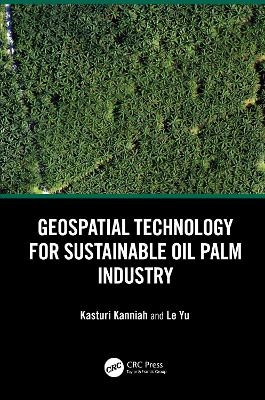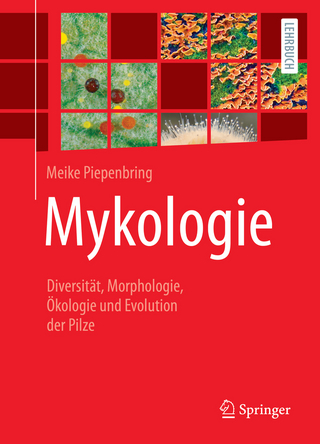
Geospatial Technology for Sustainable Oil Palm Industry
CRC Press (Verlag)
978-0-367-19009-5 (ISBN)
Oil palm cultivation is a significant contributor to the global agricultural industry, providing valuable resources for various products. While it has faced challenges, including concerns about deforestation and environmental degradation, it is crucial to understand the geographical distribution of oil palms to ensure responsible and sustainable management.
This book introduces the application of geospatial technology to the palm oil industry, demonstrating how these tools can address key issues while promoting responsible practices. The topics discussed in the book aim to tackle challenges such as illegal deforestation and the monitoring of environmental impacts associated with oil palm cultivation.
Key Features:
The first book to explore the use of remote sensing and geospatial technologies for mapping and monitoring oil palm plantations
Introduces cutting-edge techniques from the fourth industrial revolution, including the use of the Internet of Things (IoT), Artificial Intelligence, big data and analytics, block chain and 5G technology for effective oil palm tree monitoring
Addresses current environmental concerns affecting the industry, including issues like floods, changes in precipitation, temperature, humidity, and El Niño events
Explores the scientific aspects of promoting sustainability in oil palm developments and the responsible conversion of rainforests into oil palm plantations
Provides a wealth of application data for early detection and continuous monitoring of environmental challenges.
This book serves as an insightful resource for those interested in geospatial technologies and their positive impact on monitoring and mitigating environmental changes in the context of the palm oil industry.
Dr. Kasturi Devi Kanniah is a professor at the Department of Geoinformation, faculty of Built Environment and Surveying, Universiti Teknologi Malaysia (UTM). Her academic journey is marked by an unwavering commitment to environmental sustainability. As a member of the Centre for Environmental Sustainability and Water Security at UTM and a valued member of the TropicalMap research group within the Sustainability Research Alliance, Dr. Kanniah’s research primarily focuses on bridging field data with remote sensing technology. This synergy provides invaluable insights into large-scale changes in land use and land cover, as well as the intricate dynamics of vegetation processes. Her research extends across both rural and urban environments, shedding light on their pivotal role in the pursuit of low carbon cities and the mitigation of atmospheric pollution. She is recognised as a fellow member of the Malaysia Academy of Sciences and a senior member of the Institute of Electrical and Electronic Engineers (IEEE), reflecting her exceptional standing in the academic and scientific circles. Beyond her research portfolio, Dr. Kanniah serves as the Associate Editor of the International Journal of Remote Sensing (IJRS) and holds an Editorial Board position at the International Journal of Geoinformatics (IJG). She has also curated special issues for IJG, IJRS, and Remote Sensing. Throughout her illustrious career, Dr. Kanniah has earned numerous national and international awards for her exceptional research and publications, further solidifying her position as a top-tier scientist in the world. Her awards include recognition as one of the world's top 2% scientists in 2021, 2022 and 2023. In recognition of her outstanding contributions, Dr. Kanniah was a Global Scholar Programme awardee at the Institute for Social Sciences Research, University of Dundee, UK, and a visiting researcher at Tsinghua University, China, in 2022. Dr. Le Yu is an Associate Professor at the Department of Earth System Science, Tsinghua University. His research has been on the use of geographical information techniques to monitor and model global land use change, especially cropland and to facilitate many applications, e.g., food security, biodiversity conservation, and land system modelling. He particularly focuses on satellite-based methods to quantify the spatiotemporal change of land cover/use and understand their ecological, environmental, and socioeconomic impacts on sustainable development. He is Scientific Steering Committee (SSC) member of the Global Land Programme (GLP), Fellow of the Royal Geographical Society (RGS-IBG), Fellow of the Higher Education Academy, Senior Member of the Institute of Electrical and Electronics Engineers, and Prominent Visiting Researcher at the University of Technology Malaysia (UTM). He is currently Editor-in-Chief of Geo: Geography and Environment, Section Editor-in-Chief of LAND, Associate Editor of International Journal of Remote Sensing, and editorial board member of Global Sustainability and Geoscientific Model Development.
1. Oil Plam as a Commercial Crop 2. Remote Sensing 3. Geographical Information System 4. Geomatics 5. Mapping Oil Palm Land Use 6. Oil Plam Tree Detection 7. Age Classification of Oil Palm Trees 8. Topographic Mapping 9. Productivity and Yield Forecasting of Oil Palm 10. Oil Palm Pest and Disease Detection 11. Climate Suitability for Oil Palm Expansion 12. Carbon Cycle in Oil Palm Planation 13. Sustainability 14. Envrionmental Sustainability 15. Oil Palm and Social Sustainability 16. Sustainable Palm Oil 17. Future Outlook
| Erscheinungsdatum | 19.04.2024 |
|---|---|
| Zusatzinfo | 43 Tables, black and white; 11 Line drawings, color; 22 Line drawings, black and white; 18 Halftones, color; 42 Halftones, black and white; 29 Illustrations, color; 64 Illustrations, black and white |
| Verlagsort | London |
| Sprache | englisch |
| Maße | 156 x 234 mm |
| Gewicht | 712 g |
| Themenwelt | Naturwissenschaften ► Biologie ► Botanik |
| Weitere Fachgebiete ► Land- / Forstwirtschaft / Fischerei | |
| ISBN-10 | 0-367-19009-5 / 0367190095 |
| ISBN-13 | 978-0-367-19009-5 / 9780367190095 |
| Zustand | Neuware |
| Informationen gemäß Produktsicherheitsverordnung (GPSR) | |
| Haben Sie eine Frage zum Produkt? |
aus dem Bereich


